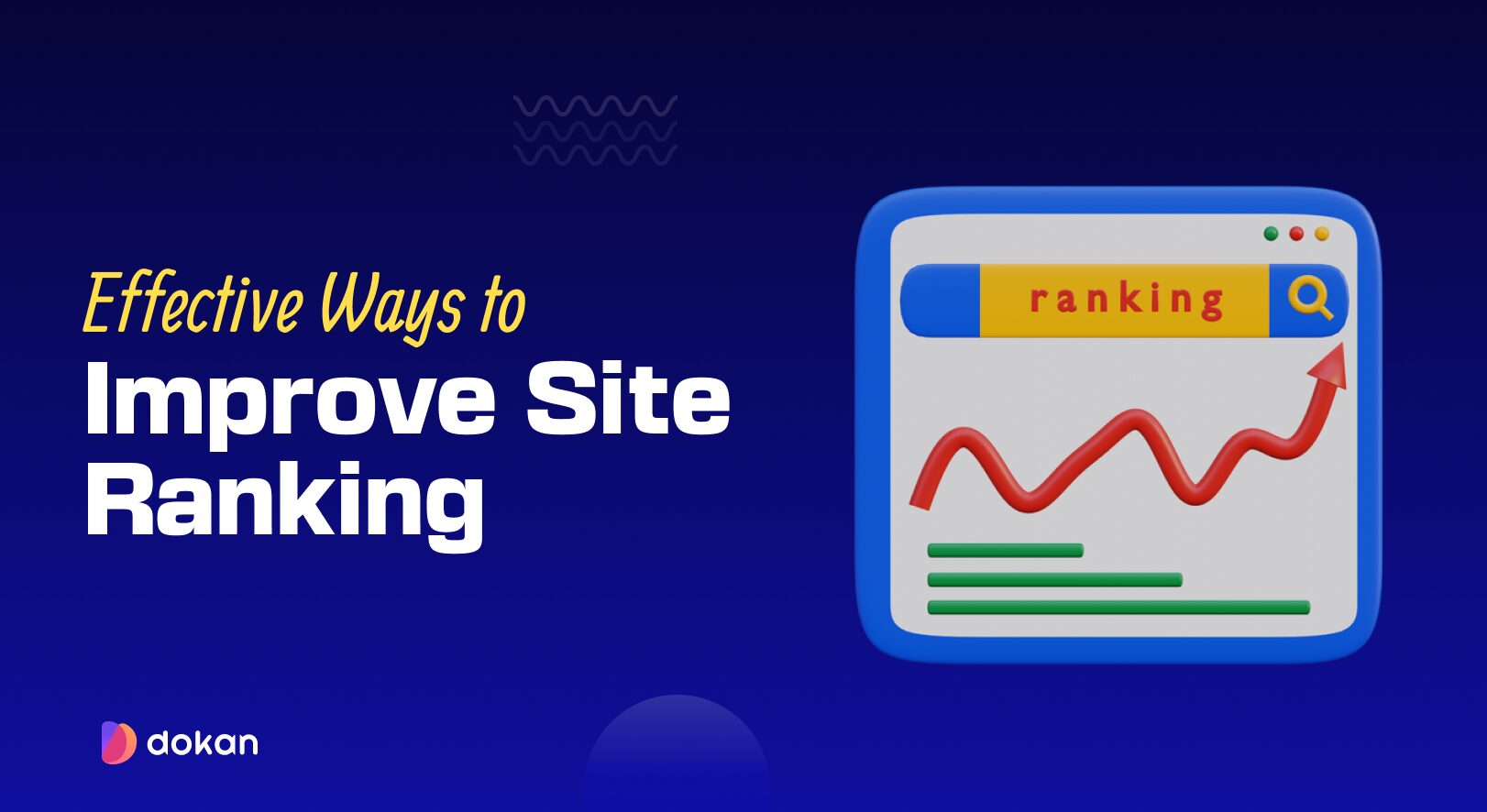Who doesn’t want more traffic, more clicks, and better brand visibility? Luckily, SEO helps you to improve your site’s ranking and make it more visible online.
It requires a few simple steps to make a big impact. You should –
- use the right keywords
- write clear page titles, and
- build quality backlinks.
These signals tell search engines that your site is relevant and trustworthy, which helps you rank higher and attract more visitors.
But with so much SEO advice out there, it’s easy to feel overwhelmed.
Don’t worry—we’ve got you covered! In this guide, we’ll walk you through tried-and-tested strategies to improve site ranking with ease.
Let’s get started!
1. Start With A Rock-Solid Technical SEO & UX Foundation
Technical SEO and user experience (UX) are important for achieving higher search rankings. If your website has slow loading times, broken links, or poor mobile usability, it will struggle to rank well in search results.
Google prioritizes websites that provide a seamless, efficient, and accessible experience to users.
A fast-loading site improves engagement, reduces bounce rates, and signals reliability to search engines. Fixing broken links enhances site structure and navigation, preventing users from encountering errors.

Mobile usability is crucial, as Google uses mobile-first indexing, meaning sites that aren’t optimized for mobile will rank lower.
A technically sound website with a user-friendly experience boosts both visibility and conversions.
Technical SEO and UX Priorities:
- Optimize images, enable caching, and use a CDN to improve page load times.
- Ensure your site functions well on all devices and screen sizes.
- Use robots.txt and XML sitemaps correctly so Google can efficiently index your pages.
- Implement HTTPS for a secure browsing experience.
- Use tools like Google Search Console to identify and resolve broken links.
Our Recommendation:
Perform a detailed SEO audit using tools like Google Search Console, PageSpeed Insights, and Screaming Frog. Address any technical issues before focusing on content and backlinks.
2. Create Helpful, E-E-A-T Content
Google’s algorithm prioritizes content that demonstrates Experience, Expertise, Authoritativeness, and Trustworthiness (E-E-A-T) to ensure users receive high-quality, reliable information.
Your content must be well-researched, insightful, and backed by credible sources to establish expertise.
Authoritativeness is built through backlinks from reputable sites and recognition within your industry. Trustworthiness comes from transparency, accuracy, and a secure website.
Aligning content with user intent—whether informational, navigational, or transactional—improves relevance and engagement, improving search rankings and user satisfaction.
Google-Friendly Content Tips:
- Make sure content is engaging, and valuable, and answers search queries effectively.
- Reference studies, and statistics to improve credibility.
- Images, videos, and infographics improve content engagement and retention.
- Make sure content aligns with what users are searching for.
Our Recommendation:
Regularly update and expand content to align with user expectations and Google’s quality guidelines. Use keyword research tools to identify high-intent topics.
3. Optimize Your Pages For Google
Even the best content needs proper optimization to rank well on Google. To improve visibility, focus on keyword optimization, ensuring that primary and related keywords are naturally integrated into titles, headings, and body content.
On-page SEO elements like meta titles, meta descriptions, and structured data help search engines understand your content.
Read: Which Marketplace Platform Provides Better SEO
Internal linking improves site structure and keeps users engaged, while image optimization (using alt text and compressed files) enhances accessibility and page speed.
Lastly, mobile-friendliness and fast-loading pages are crucial for both user experience and rankings, as Google prioritizes responsive, high-performance websites.
Tactics to Optimize Your Content:
- Titles should be concise, keyword-rich, and compelling.
- Meta descriptions should summarize the page content.
- Link to relevant pages to improve crawlability.
- Use descriptive anchor text that provides context.
- Use clear headings (H1, H2, H3) to organize content.
- Break up text with bullet points, short paragraphs, and subheadings.
- Prioritize readability with a conversational tone and simple language.
Our Recommendation:
Use on-page SEO tools like Rank Math or Yoast SEO to optimize each page efficiently. Perform regular audits to refine meta tags and structure.

4. Implement Schema Markup For Rich Results
Schema markup helps search engines interpret your content more effectively, enabling them to display rich snippets, such as star ratings, FAQs, and product details, in search results.
This enhanced visibility makes listings more attractive, improving click-through rates (CTR) and driving more organic traffic.
By structuring data with schema, websites can provide clearer context to search engines, increasing the chances of appearing in featured snippets and other prominent SERP features.
Sample Schema Markup–
{
"@context": "https://schema.org",
"@type": "Article",
"headline": "How Long Does It Take To Improve Google Rankings?",
"author": {
"@type": "Person",
"name": "Your Name"
},
"datePublished": "2025-01-30"
}Choose The Right Schema Type
- Article for blog posts
- Product for eCommerce pages
- FAQ for Q&A sections
- LocalBusiness for business websites
How To Implement Schema Markup
Here’s how you can add schema markup-
- Use Google’s Structured Data Markup Helper.
- Add JSON-LD markup manually or via a plugin.
- Test it using Google’s Rich Results Test.
Benefits Of Schema Markup
Adding schema markup has its benefits. Including-
- Improves visibility in SERPs.
- Increases CTR with enhanced snippets.
- Helps Google understand your content better.
Our Recommendation
Implement schema markup on key pages and monitor its impact using Google Search Console.
5. Build High-Quality Backlinks
Backlinks remain a crucial ranking factor, but their quality matters more than sheer quantity.
High-authority, relevant backlinks from trusted sources signal credibility and trustworthiness to search engines, boosting rankings.
Low-quality or spammy links, on the other hand, can harm SEO and lead to penalties. Earning backlinks through valuable content, guest blogging, and industry partnerships ensures sustainable growth and strengthens domain authority.
Strategies For Earning Quality Backlinks
- Write for reputable sites in your niche.
- Find and replace broken links with your content.
- Share valuable content with influencers and bloggers.
- Use HARO (Help A Reporter Out) and provide expert insights for journalists.
Our Recommendation
Use tools like Ahrefs, Moz, or SEMrush to track and acquire high-quality backlinks.
6. Maintain Content Freshness
Google gives preference to content that is consistently updated and stays relevant in the long term. This approach helps ensure that users receive accurate, timely, and valuable information.
When you update your content to reflect the latest trends, data, or developments in your industry, Google recognizes that you’re committed to providing high-quality resources that meet user needs.
Additionally, regularly refreshed content indicates that your website is active, improving the chances of it ranking higher in search results.
By keeping your content updated, you’re not just improving your search engine rankings but also making sure your audience continues to find the information they need, even as trends and technologies evolve.
Tips For Keeping Content Fresh
- Update old articles with new data, insights, and keywords.
- Repurpose content into videos, infographics, or podcasts.
- Regularly review and remove outdated information.
Our Recommendation
Perform a content audit every 6 months and update key pages for continued relevance.
How Long Does It Take To Improve Google Rankings?
Google ranking improvement is not an overnight process. The timeline varies based on factors such as competition, website authority, content quality, and SEO strategy.
Noticeable improvements can take anywhere from a few weeks to six months or more. However, by following a structured approach, you can speed up the process and achieve sustainable rankings.
Follow the SEO Fundamentals
Any improvement in Google rankings takes time. But the core principles that drive success should remain the same:
- Make sure your website is fast, secure, and easy for search engines to crawl.
- Content should be valuable, relevant, and aligned with user intent to attract and engage visitors.
- Optimize titles, meta descriptions, and headings, that help search engines understand and rank your content better.
- Gain high-quality backlinks from authoritative sites that signal to Google that your website is trustworthy and valuable.
- Keep content fresh and target local SEO factors so your site remains competitive and visible.
By implementing these strategies, you’ll set your website up for long-term SEO success and steady ranking improvements.
Subscribe to
Dokan blog
We send weekly newsletters, no spam for sure!






Leave a Reply